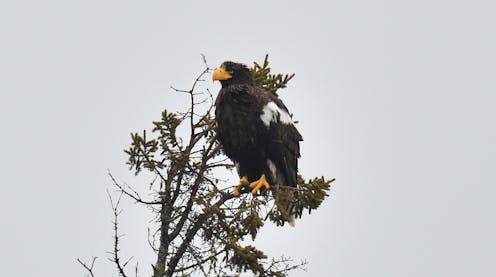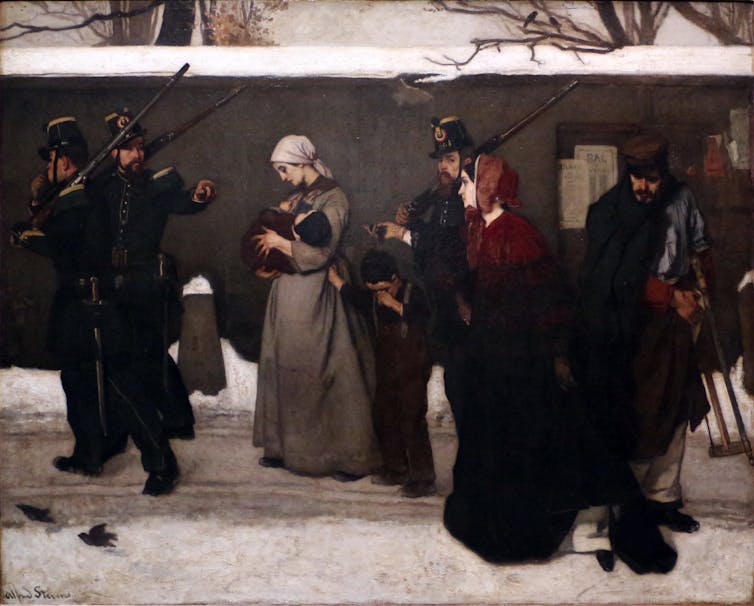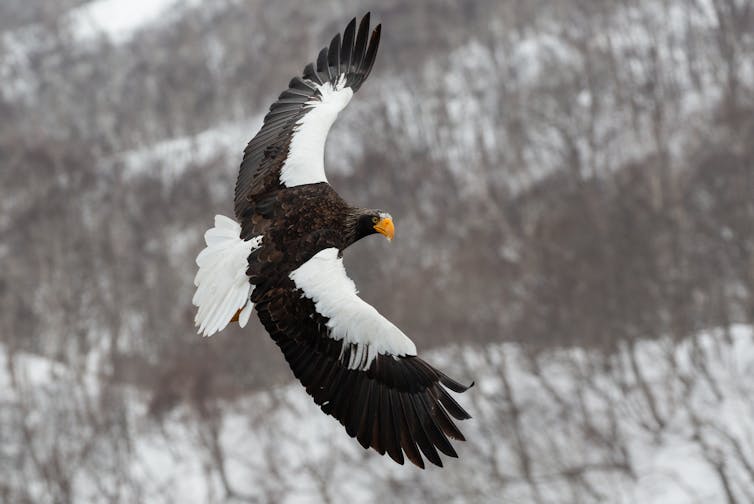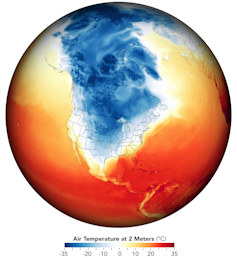Vagrant, machine or pioneer? How we think about a roving eagle offers insights into human attitudes
A Steller’s sea eagle, native to the Asian Arctic, has traveled across North America since 2021. A scholar questions whether the bird is lost – and how well humans really understand animals’ actions.

The Steller’s sea eagle is one of the largest and most aggressive raptors in the world. With an 8-foot wingspan and striking white markings, these birds tower over their bald eagle cousins.
Steller’s are sublime, but they aren’t beautiful in the way people often sentimentalize animals. Most adult Steller’s survived by beating their weaker sibling to death in the nest within weeks of birth and were rewarded for their aggression by nurturing parents. No wonder they can fight off brown bears and hunt on the sea ice of the Russian Arctic.
Since mid-2020, one individual Steller’s sea eagle has drawn national media attention because of the vast distances it has traveled – from Russia’s Kamchatka Peninsula to Alaska, then to Texas, eastern Canada, New England, and most recently, a reported sighting on May 2, 2023 in Newfoundland – and the extreme lengths to which birders are going to glimpse it.
Biologists have learned remarkable things about migratory birds’ navigational skills and how they can malfunction because of weather or illness. But these discoveries cannot answer the questions that most interest me. Can a bird travel for curiosity or pleasure, and not just for necessity or instinct? And if it can, how would we know it?
This last question is important, because it’s possible that humans are oblivious to the agency of the nonhuman world around us. In my view, anomalies like this Steller’s can open brief windows beyond our anthropocentrism.
I research environmental humanities and the social dimensions of science, and these questions are currently at the heart of these fields. I believe the extraordinary voyage of this raptor invites us to ask pressing questions about epistemology – how science knows what it knows. It also reveals hidden assumptions on which we rely when we presume that humans alone have the capacity to act for reasons that biology or environment cannot entirely explain.
The language of vagrancy and belonging
When migratory birds like this sea eagle appear outside their typical range, ornithologists call them “vagrants.” The scientific language of belonging draws on a shared cultural vocabulary for both human and nonhuman beings. Terms like vagrant, native, invasive, migrant and colonist all emerge from centuries of political discourses describing which persons belong where.
Vagrancy laws punished the itinerant poor beginning in Elizabethan times, scapegoating “vagabonds” for spreading disease, disorder and idleness. In the 19th-century U.S., a new wave of vagrancy laws targeted freed Black Americans and then migrant laborers from southeastern Europe. The latter were known as “birds of passage,” the original term for migratory birds.

An 18th-century naturalist studying bird migration, Mark Catesby, described what modern ornithologists call exploratory migratory behavior by comparing the birds to his contemporaries: “Analogous to the lucrative searches of man through distant regions, birds take distant flights in quest of food, or what else is agreeable to their nature.”
Writing in the age of exploration and colonization, Catesby simultaneously humanized birds’ inquisitive flights and naturalized Europeans’ exploration and colonization. Today, scientists and birders do the same thing. We describe birds’ anomalous movements through the dominant paradigms of our time: instinct, mechanized responses to environmental cues and genetics.
Birds as machines
I turned to two bird biologists to ask whether this Steller’s could be traveling for reasons of volition, not just instinct or necessity. In response, both ornithologists used the same word to describe the birds they study and admire: machines.
Ultimately, it seems, no matter how far you fly, there is no escaping the “hard-wired” mechanism that confines the nonhuman world in most experts’ view. As biologist E.O. Wilson summarized, “All animals, while capable of some degree of specialized learning, are instinct driven, guided by simple cues from the environment that trigger complex behavior patterns.”
But reducing nonhuman animals to machines lacking agency ignores the surprising history of machines. Historian of science Jessica Riskin argues that the tradition of seeing all biological life – humans included – as clocklike machines includes an overlooked dimension in which “machine-like meant forceful, restless, purposeful, sentient, perceptive.” Machines were seen by some scientists from the Enlightenment period as lifelike: self-organizing, unpredictable and restless mechanisms driven by a vital inner agency.
Machines have always been more than just machines. This “contradiction … at the heart of modern science” – the restless vitality of mere “machines” – is precisely what this eagle’s singular behavior manifests for us. As a fugitive from the confines of our knowledge, this raptor is as much a machine as you or I, and just as capable of surprising.
Birds as persons
Although scientists have traditionally reduced many aspects of animal life to biological mechanisms, new research is challenging this perspective. Recent studies show that animals exhibit remarkable ranges of sexual expression as well as playing and dreaming behaviors. These findings are driving exciting investigations into animals’ inner lives and their capacity for joy and spontaneity.
However, even when researchers study individual bird personality as a possible explanation for why “bold and aggressive bird individuals” are more prone to vagrancy than shy individuals, they reduce personality to particular genes.
By suggesting that the wide-ranging sea eagle may be willfully exploring, some might say I am anthropomorphizing her. But the problem of anthropomorphism is culturally and historically specific. Not all cultures do it, or do it in the same way.

In contrast to Western cultures, many Indigenous peoples – along with believers in animism – live in a world shared with diverse persons, only some of them human. In these cultures, anthropomorphism is not an issue: All living organisms like plants and animals – and even nonliving ones, like glaciers or mountains – may be considered as animate persons – subjects and agents that merit ethical consideration, not merely objects to be cared for or used. A global “rights of nature” movement is gaining ground as a legal strategy rooted in such Indigenous ideas of relating to nonhuman persons.
In the Steller’s sea eagle’s home of Kamchatka and the Amur estuary, myths abound of giant eagles that carry off whales and hunters. Before Christian conversion three centuries ago, people there described the creator of the world, and of humans, as a raven called Kutkkh, a powerful being across the North Pacific to be feared and respected – a person to be reckoned with.
Symbol or anomaly?
The roaming sea eagle’s initial journey from Alaska to Texas in March 2021 followed a record-breaking southward plunge of Arctic air in February 2021. This deadly event sent temperatures plummeting below freezing in Texas and U.S. Sen. Ted Cruz fleeing to Cancún.

The Arctic is the fastest-warming zone on Earth. Only some 6,000 Steller’s remain, because of climate change and human disturbance – especially Russian oil production around Sakhalin. The extraordinary movements of Arctic air and of this singular eagle bring the distant consequences of climate change far south, into the Texas oilfields.
Scientists now think that vagrants may be playing an important role as “first responders” to environmental changes, and “vanguards” of range shifts. This shift from vagrant to vanguard may be a radical and welcome change. But it also highlights the tenacious power of anthropocentrism in always seeing animals as human analogs.
Beyond categories
For the past two winters, I have trekked to Maine hoping to spot the roving Steller’s. In February 2023 I ended up on the same frozen bridge on Maine’s Back River as in 2022, along with my teenage son and dozens of birders from across the continent.
One birder who had flown from Minnesota to see the eagle – and, like me, never did – offered to nail a nickel to the bridge as a reward for the first of us to spot the elusive prey. He was referring to a scene in Herman Melville’s “Moby-Dick” in which Ahab nails a gold doubloon to the mast as a promised reward for being first to spot the white whale.
In the scene, each crew member reads the symbols on the coin in a highly subjective way. As Ahab says, “every man but mirrors back his own mysterious self”: The act of interpreting an image or animal is deeply subjective. This theme is central to “Moby-Dick” and is why the book inspires more symbolic readings than perhaps any other novel.
Philosophers Gilles Deleuze and Félix Guattari read the white whale as a provocation to see beyond dualistic categories and symbols. They see the whale as “The Anomaly” – a dangerous flight from normative categories like normal/abnormal, human/nonhuman. Like this sea eagle, Moby-Dick “is neither an individual nor a genus; he is the borderline.” He resists the very possibility of categorization, not merely the categories themselves.
To embody “a phenomenon of bordering” in this way is to test and hopefully evade the powers of symbol-making animals like ourselves. Keeping the mind open to this Steller’s sea eagle as an anomaly in this sense is freeing for eagles and other persons, including humans. I believe this rare bird’s fugitive journey offers an even rarer glimpse of the mysterious intentions of animals as individuals, traveling at the borderline of our imaginations and beyond.
Adriana Craciun does not work for, consult, own shares in or receive funding from any company or organisation that would benefit from this article, and has disclosed no relevant affiliations beyond their academic appointment.
Read These Next
West Antarctica’s history of rapid melting foretells sudden shifts in continent’s ‘catastrophic’ geo
A picture of what West Antarctica looked like when its ice sheet melted in the past can offer insight…
The world risks forgetting one of humanity’s greatest triumphs as polio nears global eradication − 7
Polio may finally be defeated in the next 5 years. Will the world recognize what an extraordinary achievement…
Autocracies in transition: In 2025, Cameroon and Tanzania rulers clung to power — but look more vuln
The countries, whose respective leaders recently won widely disputed elections, offer contrasting examples…






